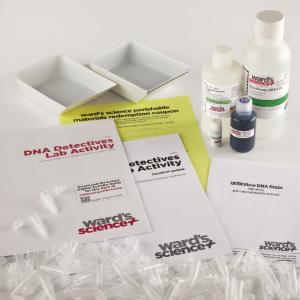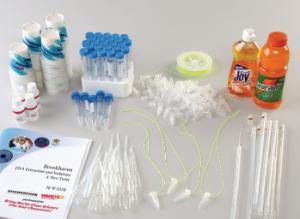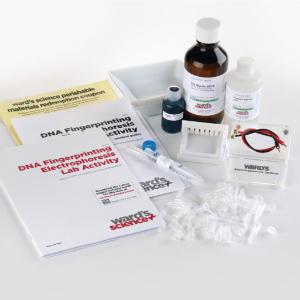Double (helix) the fun with this DNA activity
Middle/High School
What do CSI Miami, 23andMe, canola Oil, seedless watermelon, Dolly the sheep, and The Innocence Project have in common? They all rely on DNA science.
DNA stands for deoxyribonucleic acid and is one of the two types of nucleic acid found in cells along with RNA . We're all interested in what's in our DNA, the genetic code personalized to each of us. DNA fingerprinting is a molecular procedure that reveals DNA patterns unique to each individual. The results show up as a pattern of bands that can be matched against other samples.
This hands-on activity uses common household supplies to teach students a technique for extracting the genetic code that makes them who they are—a skill they'll want to under-STRAND.
All you’ll need are a few simple supplies that include a cup or glass, your favorite sports drink, Isopropyl alcohol, and some dish soap:
Download the full activity below, and keep reading to learn more about DNA.
What is DNA?
DNA is found in every living organism. It is the genetic material that tells the cells what to do. DNA is the boss, the head honcho, the rule maker. It gives cells instructions in the form of a series of "codons," which are three-block codes (there are 64 permutations of this code). Check out how viruses use their DNA to totally rule the cells they invade.
DNA is made up of nucleotides comprising A, T, G, and C (which stand for adenine, thymine, guanine, and cytosine). These are chemical bricks composed of a sugar, a nitrogenous base, and a phosphate molecule that build up the entire DNA structure.
Scientists use the term "double helix" to describe DNA's winding, two-stranded chemical structure. This shape - which looks much like a twisted ladder - gives DNA the power to pass along biological instructions with great precision—aye-aye, captain!
What is DNA fingerprinting, and how is it used?
DNA fingerprinting is a method used to identify an individual from a sample of DNA by looking at unique patterns in their DNA. The probability of having two people with the same DNA fingerprint that are not identical twins is very small.
The technique involves finding clues and piecing together a puzzle to solve scientific mysteries such a forensics (crime scenes, suspect identification, body ID), parental testing, or genealogy.
So, ask your students to put their detective hats on and get started on this simple activity that will help them explore and develop their knowledge of DNA. You just may inspire someone to become part of a real-life CSI team or help find the perfect organ match for someone on the transplant list.
Recommended Products:
[StartProductBlock]

Ward's® DNA Detectives Lab Activity
In this lab activity, students will use restriction enzymes to digest the DNA of four suspects in a criminal investigation and separate the DNA samples using agarose gel electrophoresis. This kit has been aligned with all published National Standards. Pre- and Post-laboratory assessments and vocabulary words all target specific Science and Engineering Practices and common core standards.
[EndProductBlock]
[StartProductBlock]

DNA On A Chain Kit
This DNA extraction lab involves a fun twist that both simplifies the process and helps guarantee students' understanding. Students swish a sports drink (not included) in their mouths to break open or lyse their cheek cells.
[EndProductBlock]
[StartProductBlock]

Ward's® DNA Fingerprinting Electrophoresis Lab Activity
With this electrophoresis system, students can perform the same type of gel separation used in these analyses in approximately two hours; students are given DNA samples from a "crime scene" to electrophorese and discover who perpetrated the crime by analyzing their unique genetic patterns or fingerprints.
[EndProductBlock]
